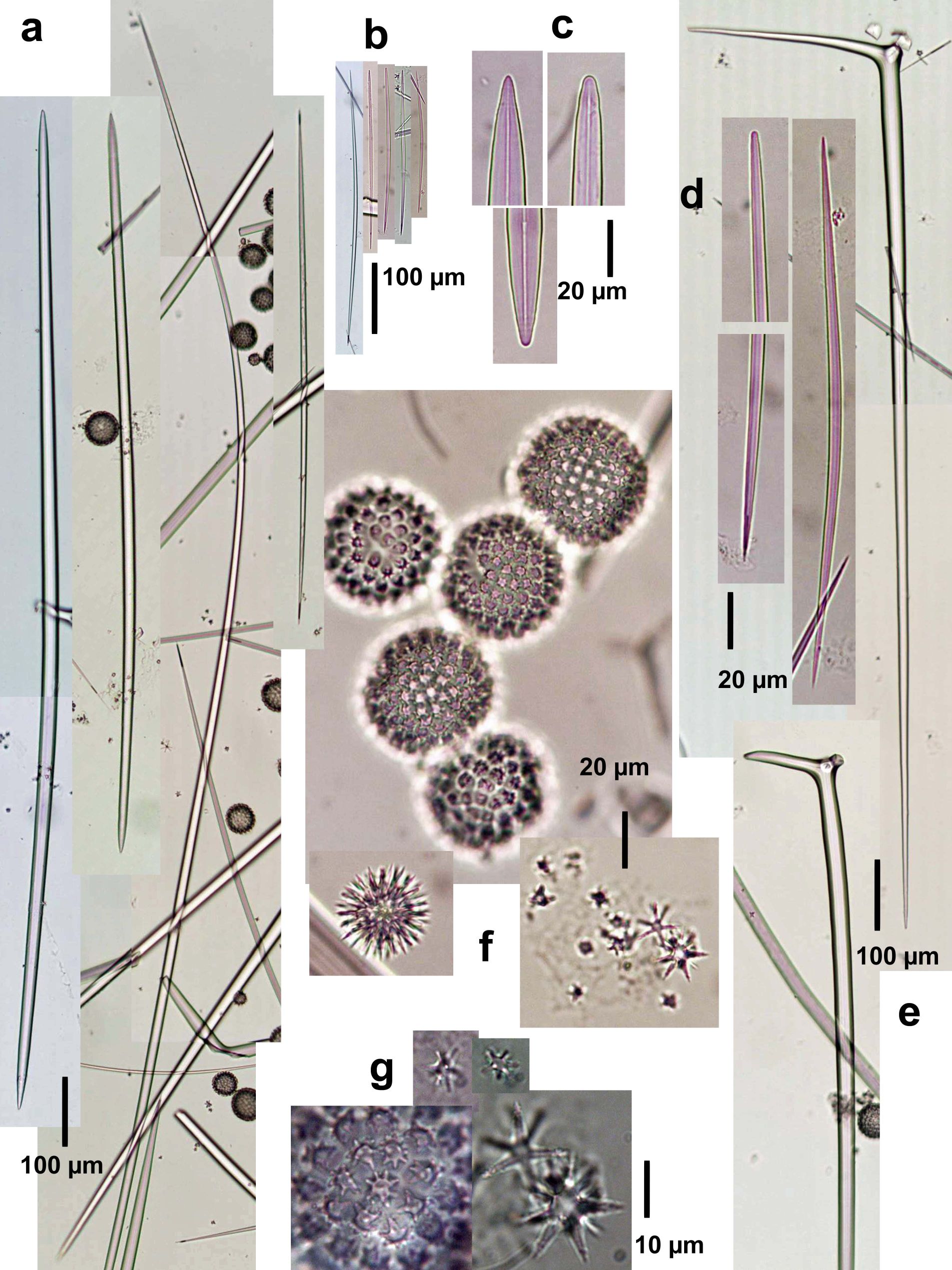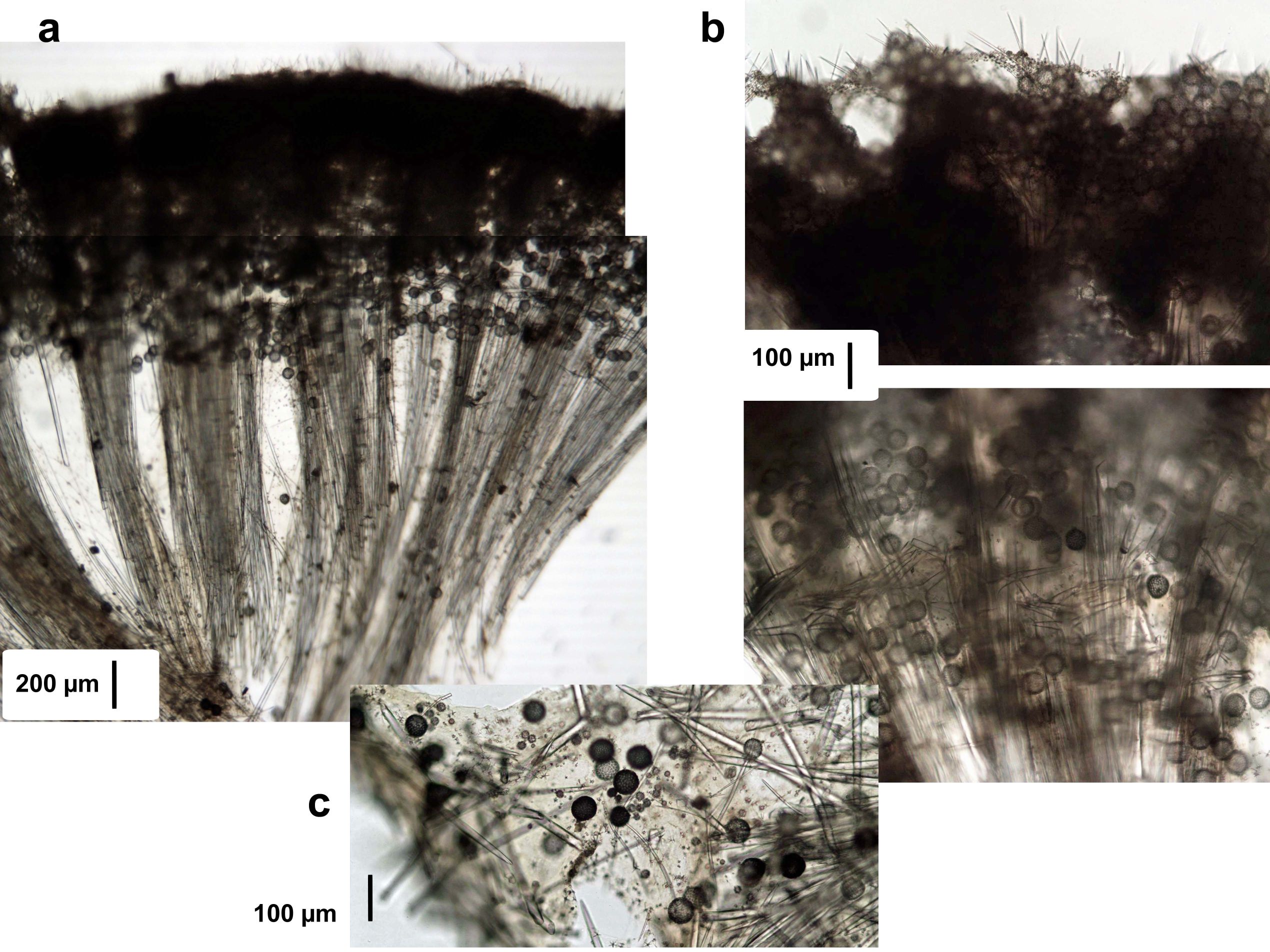the Sponge Guide - www.spongeguide.org
Observed Characteristics:
brown
massive
tough
United States
Species Description and Notes
Description: Massively encrusting, some 10-20 cm in diameter and about 5 cm thick. Surface irregular, heavily fouled by other organisms, and with scattered and irregular cleaner valleys of inhalant pores; unexposed sides also with fields of pore sieves. In the top center there is a clean, round depression containing the oscules in a concave plate. Color of external visible parts is dark brown; interior cream. Consistency tough, especially the cortex, which is difficult to cut. The peripheral skeleton from exterior to interior is conformed first by a cortex of densely packed sterraster microscleres, up to 500-600 µm in thickness, traversed horizontally and vertically by canals, and vertically by choanosomal megasclere tracts. The pinacoderm is stretched above the cortex, being heavily embedded by the smaller category of aster microscleres and traversed by bouquets of the smaller category of anystrongyloxea-oxea II megascleres. The lower part of the sterraster cortex is more diffuse and has internal invaginations that reach more or less halfway up through it. Slightly below the cortex the triaene megascleres are aligned with their cladomes upwards, in one to several layers, often with an additional less dense sterraster layer 1-3 spicules thick immediately below. From the choanosome, thick tracts of 5-10 megascleres or more, 80-120 µm in diameter, ascend and diverge, ending below or traversing in the sterrastral cortex. Further inwards, the tracts are looser, with many spicules in confusion, and with aster microscleres embedded in the pinacoderm lining canals. Megasclere spicules in three types: (1) Oxea I, slightly curved, fusiform to hastate, slender to stout, more often with both ends acute but sometimes with one end blunt (anysostrongyloxea), in a great variety of sizes, the smallest slender and fusiform, the largest usually stout and hastate, 510-1500 µm long (one fusiform reaching 3325 µm) and 5.2-25 µm wide. (2) Anysostrongyloxea-oxea II, slightly curved, often with one end blunt, forming the superficial bouquets but also interspersed in the choanosome, 210-430 µm long and 4.8-5.5 µm wide; there are some intermediate sizes in between I and II diactine megasclere categories. (3) Plagiotriaenes, with short to long but stout and usually acute clades, 20-280 µm long and up to 25.5 µm wide at the base; rhabds stout, elongated and acute, 750-1400 µm long and 27-5-32.5 µm wide. Microscleres in two basic types: (1) Sterrasters, round, relatively small, 40-55 µm in diameter, with relatively large and few spined rosettes, up to about 5 µm in diameter; developmental stages are smaller balls surrounded by thin needles to larger ones surrounded by conical stout conical spines from which the rosettes would develop. (2) Asters in 2-3 categories (difficult to discern under light microscopy), with spined rays; large oxyasters with 5-8 slender rays, 22.5-26.3 µm in total diameter; intermediate stouter oxyasters, with up to 10 or more rays, 15-16.3 µm in diameter; and smaller strongyl- or oxyasters, some robust some slender, 7.5-12.5 µm in total diameter.
Notes: This species was found inhabiting the shaded vertical faces of highway concrete pilings in Biscayne Bay, off Miami, Florida, in depths between low tide and 1-2 m. We initially identified it as G. gibberosa Lamarck, 1815, but upon examination and sequencing of our material by Paco Cárdenas (Uppsala University, Sweden) it was concluded it belongs to a new species to be described, inhabiting shallow sandy or seagrass beds of the Florida Bay and Biscayne Bay. Differences in spiculation among Geodia species are quite subtle, so that identification relies mostly in external shape and perhaps skeletal architecture. Comparing our material, this species stands out for its rather small sterrasters with relatively large rosettes, a feature shared with G. aff. corticostylifera and G. neptuni, species with which it can be readily distinguished by shape.
Tissue and Spicule Images

Spicule Images: a) Oxeas I; b) anysostrongyloxeas-oxeas II, c) enlarged end of oxeas I; d) enlargement of oxeas-anysostrongyloxeas II; e) plagiotriaenes; f) microscleres (sterrasters, developed and developing; spined asters in 2-3 types, oxyasters and strongyl- or oxyasters); g) enlargement of microscleres (rossettes of sterrasters on the left). Sample from South Florida.
Source Specimen: http://www.spongeguide.org/ thumbs/00072/01325.JPG

Tissue Images: a) Perpendicular section at the surface; b) magnification at the surface (above) and subsurface (below); c) magnification of the choanosome. Sample from South Florida.
Source Specimen: http://www.spongeguide.org/ thumbs/00072/01325.JPG
Images
Geodia sp.-"Biscayne Bay"
Location: United States, Florida, Biscayne Bay
Photographer: Sven Zea
Location: United States, Florida, Biscayne Bay
Photographer: Sven Zea